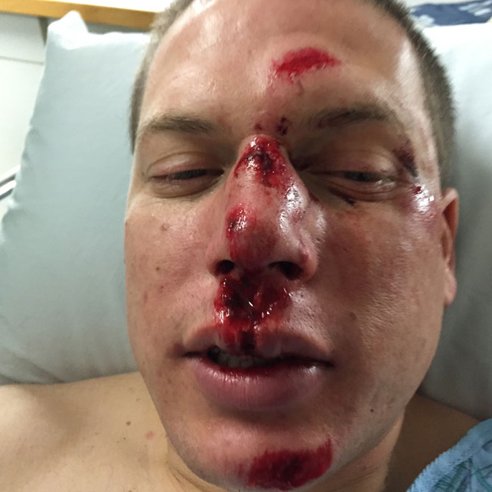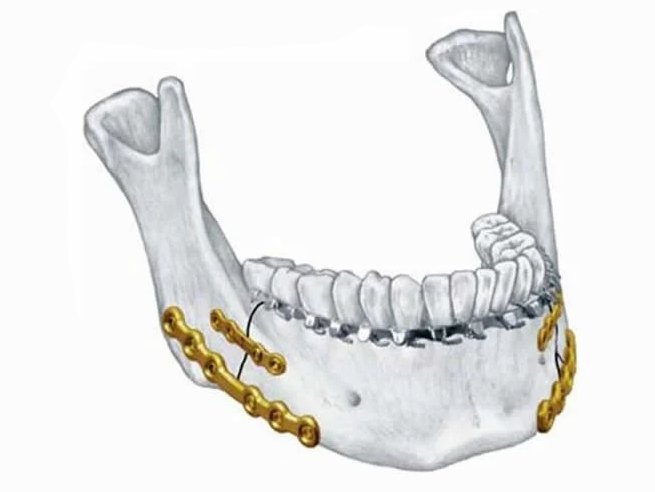


Dental Services |
 Facial trauma is any injury of the face and upper jaw bone (maxilla). Causes As per our expert maxillofacial surgeon blunt or penetrating trauma can cause injury to the area of the face that includes the upper jaw, lower jaw, cheek, nose, or forehead. Common causes of injury to the face include : Automobile accidents Penetrating injuries Symptoms Changes in sensation and feeling over the face Deformed or uneven face or facial bones Difficulty breathing through the nose due to swelling and bleeding Double vision Missing teeth Swelling around the eyes that may cause vision problems Patients who cannot function normally or who have significant deformity will need surgery. The goal of treatment is to: Control bleeding Create a clear airway Fix broken bone segments with titanium plates and screws Leave the fewest scars possible Rule out other injuries Treat the fracture Treatment should be immediate, as long as the person is stable and there are no neck fractures or life-threatening injuries.
Facial trauma is any injury of the face and upper jaw bone (maxilla). Causes As per our expert maxillofacial surgeon blunt or penetrating trauma can cause injury to the area of the face that includes the upper jaw, lower jaw, cheek, nose, or forehead. Common causes of injury to the face include : Automobile accidents Penetrating injuries Symptoms Changes in sensation and feeling over the face Deformed or uneven face or facial bones Difficulty breathing through the nose due to swelling and bleeding Double vision Missing teeth Swelling around the eyes that may cause vision problems Patients who cannot function normally or who have significant deformity will need surgery. The goal of treatment is to: Control bleeding Create a clear airway Fix broken bone segments with titanium plates and screws Leave the fewest scars possible Rule out other injuries Treat the fracture Treatment should be immediate, as long as the person is stable and there are no neck fractures or life-threatening injuries.
 Corrective jaw, or orthognathic, surgery is performed by Oral and Maxillofacial Surgeons to correct a wide range of minor and major skeletal and dental irregularities, including the misalignment of jaws and teeth, which, in turn, can improve chewing, speaking and breathing. While the patient's appearance may be dramatically enhanced as a result of their surgery, orthognathic surgery is performed to correct functional problems. Following are some of the conditions that may indicate the need for corrective jaw surgery : difficulty chewing, or biting food difficulty swallowing chronic jaw or jaw joint (TMJ) pain and headache excessive wear of the teeth open bite (space between the upper and lower teeth when the mouth is closed) unbalanced facial appearance from the front, or side facial injury or birth defects receding chin protruding jaw inability to make the lips meet without straining chronic mouth breathing and dry mouth sleep apnea (breathing problems when sleeping, including snoring)
Corrective jaw, or orthognathic, surgery is performed by Oral and Maxillofacial Surgeons to correct a wide range of minor and major skeletal and dental irregularities, including the misalignment of jaws and teeth, which, in turn, can improve chewing, speaking and breathing. While the patient's appearance may be dramatically enhanced as a result of their surgery, orthognathic surgery is performed to correct functional problems. Following are some of the conditions that may indicate the need for corrective jaw surgery : difficulty chewing, or biting food difficulty swallowing chronic jaw or jaw joint (TMJ) pain and headache excessive wear of the teeth open bite (space between the upper and lower teeth when the mouth is closed) unbalanced facial appearance from the front, or side facial injury or birth defects receding chin protruding jaw inability to make the lips meet without straining chronic mouth breathing and dry mouth sleep apnea (breathing problems when sleeping, including snoring)
 Cleft lip and cleft palate are facial and oral malformations that occur very early inpregnancy, while the baby is developing inside the mother. Clefting results when there is not enough tissue in the mouth or lip area, and the tissue that is available does not join together properly. A cleft lip is a physical split or separation of the two sides of the upper lip and appears as a narrow opening or gap in the skin of the upper lip. This separation often extends beyond the base of the nose and includes the bones of the upper jaw and/or upper gum. A cleft palate is a split or opening in the roof of the mouth. A cleft palate can involve the hard palate (the bony front portion of the roof of the mouth), and/or the soft palate (the soft back portion of the roof of the mouth). How Are Cleft Lip and Cleft Palate Diagnosed? Because clefting causes very obvious physical changes, a cleft lip or cleft palate is easy to diagnose. Prenatal ultrasound can sometimes determine if a cleft exists in an unborn child. If the clefting has not been detected in an ultrasound prior to the baby's birth, a physical exam of the mouth, nose, and palate confirms the presence of cleft lip or cleft palate after a child's birth. Sometimes diagnostic testing may be conducted to determine or rule out the presence of other abnormalities.
Cleft lip and cleft palate are facial and oral malformations that occur very early inpregnancy, while the baby is developing inside the mother. Clefting results when there is not enough tissue in the mouth or lip area, and the tissue that is available does not join together properly. A cleft lip is a physical split or separation of the two sides of the upper lip and appears as a narrow opening or gap in the skin of the upper lip. This separation often extends beyond the base of the nose and includes the bones of the upper jaw and/or upper gum. A cleft palate is a split or opening in the roof of the mouth. A cleft palate can involve the hard palate (the bony front portion of the roof of the mouth), and/or the soft palate (the soft back portion of the roof of the mouth). How Are Cleft Lip and Cleft Palate Diagnosed? Because clefting causes very obvious physical changes, a cleft lip or cleft palate is easy to diagnose. Prenatal ultrasound can sometimes determine if a cleft exists in an unborn child. If the clefting has not been detected in an ultrasound prior to the baby's birth, a physical exam of the mouth, nose, and palate confirms the presence of cleft lip or cleft palate after a child's birth. Sometimes diagnostic testing may be conducted to determine or rule out the presence of other abnormalities.
 Oral cancer is part of a group of cancers called head and neck cancers. Oral cancer can develop in any part of the oral cavity or oropharynx. Most oral cancers begin in the tongue and in the floor of the mouth. Almost all oral cancers begin in the flat cells (squamous cells) that cover the surfaces of the mouth, tongue, and lips. These cancers are called squamous cell carcinomas. When oral cancer spreads (metastasizes), it usually travels through thelymphatic system. Cancer cells that enter the lymphatic system are carried along by lymph, a clear, watery fluid. The cancer cells often appear first in nearby lymph nodes in the neck. Cancer cells can also spread to other parts of the neck, the lungs, and other parts of the body. When this happens, the new tumor has the same kind of abnormal cells as the primary tumor. For example, if oral cancer spreads to the lungs, the cancer cells in the lungs are actually oral cancer cells. The disease is metastatic oral cancer, not lung cancer. It is treated as oral cancer, not lung cancer. Doctors sometimes call the new tumor "distant" or metastatic disease. Early detection : Your regular checkup is a good time for your dentist or doctor to check your entire mouth for signs of cancer. Regular checkups can detect the early stages of oral cancer or conditions that may lead to oral cancer. Ask your doctor or dentist about checking the tissues in your mouth as part of your routine exam. Symptoms Common symptoms of oral cancer include : Patches inside your mouth or on your lips that are white, a mixture of red and white, or red White patches (leukoplakia) are the most common. White patches sometimes become malignant. Mixed red and white patches (erythroleukoplakia) are more likely than white patches to become malignant. Red patches (erythroplakia) are brightly colored, smooth areas that often become malignant. A sore on your lip or in your mouth that won't heal Bleeding in your mouth Loose teeth Difficulty or pain when swallowing Difficulty wearing dentures A lump in your neck An earache Treatment : Many people with oral cancer want to take an active part in making decisions about their medical care. It is natural to want to learn all you can about your disease and your treatment choices. However, shock and stressafter the diagnosis can make it hard to think of everything you want to ask the doctor. It often helps to make a list of questions before an appointment. To help remember what the doctor says, you may take notes or ask whether you may use a tape recorder. You may also want to have a family member or friend with you when you talk to the doctor -- to take part in the discussion, to take notes, or just to listen. Your doctor may refer you to a specialist, or you may ask for a referral.Specialists who treat oral cancer include oral and maxillofacial surgeons, otolaryngologists (ear, nose, and throat doctors), medical oncologists, radiation oncologists, and plastic surgeons. You may be referred to a team that includes specialists in surgery, radiation therapy, or chemotherapy. Other health care professionals who may work with the specialists as a team include a dentist, speech pathologist, nutritionist, and mental healthcounselor.
Oral cancer is part of a group of cancers called head and neck cancers. Oral cancer can develop in any part of the oral cavity or oropharynx. Most oral cancers begin in the tongue and in the floor of the mouth. Almost all oral cancers begin in the flat cells (squamous cells) that cover the surfaces of the mouth, tongue, and lips. These cancers are called squamous cell carcinomas. When oral cancer spreads (metastasizes), it usually travels through thelymphatic system. Cancer cells that enter the lymphatic system are carried along by lymph, a clear, watery fluid. The cancer cells often appear first in nearby lymph nodes in the neck. Cancer cells can also spread to other parts of the neck, the lungs, and other parts of the body. When this happens, the new tumor has the same kind of abnormal cells as the primary tumor. For example, if oral cancer spreads to the lungs, the cancer cells in the lungs are actually oral cancer cells. The disease is metastatic oral cancer, not lung cancer. It is treated as oral cancer, not lung cancer. Doctors sometimes call the new tumor "distant" or metastatic disease. Early detection : Your regular checkup is a good time for your dentist or doctor to check your entire mouth for signs of cancer. Regular checkups can detect the early stages of oral cancer or conditions that may lead to oral cancer. Ask your doctor or dentist about checking the tissues in your mouth as part of your routine exam. Symptoms Common symptoms of oral cancer include : Patches inside your mouth or on your lips that are white, a mixture of red and white, or red White patches (leukoplakia) are the most common. White patches sometimes become malignant. Mixed red and white patches (erythroleukoplakia) are more likely than white patches to become malignant. Red patches (erythroplakia) are brightly colored, smooth areas that often become malignant. A sore on your lip or in your mouth that won't heal Bleeding in your mouth Loose teeth Difficulty or pain when swallowing Difficulty wearing dentures A lump in your neck An earache Treatment : Many people with oral cancer want to take an active part in making decisions about their medical care. It is natural to want to learn all you can about your disease and your treatment choices. However, shock and stressafter the diagnosis can make it hard to think of everything you want to ask the doctor. It often helps to make a list of questions before an appointment. To help remember what the doctor says, you may take notes or ask whether you may use a tape recorder. You may also want to have a family member or friend with you when you talk to the doctor -- to take part in the discussion, to take notes, or just to listen. Your doctor may refer you to a specialist, or you may ask for a referral.Specialists who treat oral cancer include oral and maxillofacial surgeons, otolaryngologists (ear, nose, and throat doctors), medical oncologists, radiation oncologists, and plastic surgeons. You may be referred to a team that includes specialists in surgery, radiation therapy, or chemotherapy. Other health care professionals who may work with the specialists as a team include a dentist, speech pathologist, nutritionist, and mental healthcounselor.
Designed by Seacom Digital